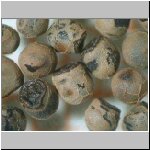 Gymnocalycium kieslingii ssp. alboareolatum STO 180, seeds from Franz Strigl
Gymnocalycium kieslingii ssp. alboareolatum STO 180, seeds from Franz Strigl|
Preface Nature is in her variety enormous, endless
and in motion. All, about we are talking, need a name. Without
botanical exactness, it is a try to overlook the genus easy and
systematic. The following list isn't complete and probable full
of mistakes. I'd like to get your hints, corrections or mentions.
Please sent me an e-mail. Bohumil Schütz A. V. Fric started the structure of the genus
Gymnocalycium by means of signs of the seeds. He published his
system in 1935 in a catalogue by Kurt Kreuzinger. The adaptation
and completion with many new species by Schuetz appeared in 1969
in the Friciana VII/46. John Donald published in the NSCJ in
1969 the complete volume in a revised translation. It is possible to divide the genus in six subgenera:
Alphabetic list known names by Metzing, Meregalli, Kiesling; Putnam and Papsch |
Vorbemerkung Die Natur ist in ihrer Vielfalt enorm, unendlich
und in Bewegung. Alles, worüber wir reden, braucht einen
Namen. Ohne botanischen Ansprüchen gerecht werden zu können,
wird hier versucht, die Gattung einfach und systematisch zu überschauen.
Die folgende Aufstellung ist nicht vollständig und vermutlich
enthält sie Fehler. Hinweise werden von mir gern angenommen
- e-mail. Bohumil Schütz A. V. Fric begann mit der Untergliederung
der Gattung Gymnocalycium nach Samenmerkmalen. Veröffentlicht
wurde sein System 1935 im Katalog von Kurt Kreuzinger.
Die Anpassung und Ergänzung mit vielen neuen Arten durch
Schütz erschien 1969 in der Friciana VII/46 und wurde im
NSCJ 1969 in einer von John Donald revidierten
Übersetzung abgedruckt. Gliederung in sechs Untergattungen:
Alphabetische Liste bekannter Namen nach Metzing, Meregalli, Kiesling; Putnam und Papsch |
Habitat: Argentina (Buenos Aires, Rio Negro, Rio Chubut,
Córdoba, Mendoza, San Luis, Catamarca,
Santiago del Estero, Salta, Entre Ríos)
Type: Gymnocalycium gibbosum
(Haworth 1812) Pfeiffer ex Mittler 1844
 Gymnocalycium kieslingii ssp. alboareolatum STO 180, seeds from Franz Strigl
Gymnocalycium kieslingii ssp. alboareolatum STO 180, seeds from Franz Strigl
|
Fruits burst when ripeness with a vertical crack. Seeds about 1 mm in diameter, spherical and truncated a the hilum end. Testa black, complete or at least partly put a brownish skin on. Hilum round, margin only delicate. Fruits and seeds get dry. |
Früchte platzen bei Reife mit einem vertikalen Spalt. Samen ca. 1 mm im Durchmesser, kugelig oder nahezu kugelig, beim Hilum auffällig abgestutzt. Testa schwarz, vollständig oder wenigstens teilweise mit einer bräunlichen Haut überzogen. Hilum rund, Randsaum nur schwach ausgebildet. Früchte und Samen werden trocken. |
G. amerhauseri H. Till 1994
G. andreae (Boedeker 1930) Backeberg 1935
G. baldianum (Spegazzini 1905) Spegazzini 1925
G. berchtii Neuhuber 1997
G. borthii Koop ex H. Till 1987
G. bruchii (Spegazzini 1923) Hosseus 1926
G. calochlorum (Boedeker 1932) Y. Ito 1952
G. capillaense (Schick 1923) Hosseus 1926
G. deeszianum Dölz 1943
G. erinaceum Lambert 1985
G. fischeri Halda 2002
G. x heidiae Neuhuber 1999
G. hyptiacanthum (Lemaire 1839) Britton & Rose 1922.
G. kieslingii Ferrari 1985
G. leptanthum (Spegazzini 1905) Spegazzini 1925
G. mackieanum (Hooker 1837) Metzing 1995
G. neuhuberi H. Till & W. Till 1992
G. platense (Spegazzini 1896) Britton & Rose 1922
G. poeschlii Neuhuber 1999
G. rauschii H. Till & W. Till 1990
G. reductum (Link 1828) Pfeiffer ex Mittler 1844
G. rosae H. Till 1995
G. schroederianum Osten 1941
G. striglianum Jeggle ex H. Till 1987
G. sutterianum (Schick 1923) Hosseus 1926
G. taningaense Piltz 1990
G. terweemeanum Teucq ex Duursma 1930) Borgmann & Piltz 1997
G. walteri H. Till 2003
G. uebelmannianum Rausch 1972
Habitat: Uruguay, East Paraguay, South Brasilia and
Northeast Argentina.
Type: Gymnocalycium denudatum
(Link & Otto 1828) Pfeiffer ex Mittler 1844
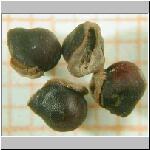 G. denudatum,
seeds from Nobert Gerloff, Herbarium Mario Wick;
G. denudatum,
seeds from Nobert Gerloff, Herbarium Mario Wick;
|
Ripe fruits always turn green bursting not always but becoming often softly and melting away. Seeds 1-3 mm in the diameter, almost spherical, something pressed together, noticeably broad in the proximity of the hilum. Testa of black, more or some dull. Hilum prolonged and pressed together a little. Hilumsaum of dark or bright, the whole Hilum surrounding. |
Reife Früchte immer grün, nicht immer platzend, sondern oft weich werdend und zerfließend. Samen 1-3 mm im Durchmesser, nahezu kugelig, etwas zusammengedrückt, merklich breiter in der Nähe des Hilums. Testa schwarz, mehr oder weniger matt. Hilum verlängert und etwas zusammengedrückt. Hilumsaum dunkel oder hell, das ganze Hilum umgebend. |
G. angelae Meregalli 1998
G. buenekeri Swales 1978
G. fleischerianum Backeberg nom. inval. 1959
G. horstii Buining 1970
G. leeanum (Hooker 1845) Britton & Rose
1922
G. megalothelos (Sencke ex K. Schumann 1898)
Britton & Rose 1922
G. mesopotamicum Kiesling 1980
G. netrelianum (Monville ex Labouret 1853)
Britton & Rose 1922
G. paraguayense (K. Schumann 1903) Schütz
1966
G. sigelianum (Schick 1923) Hosseus 1926
G. uruguayense (Arechavaleta 1905) Britton & Rose 1922
Habitat: Argentina (San Juan,
La Rioja, Catamarca, Tucuman, Salta, Jujuy, Córdoba, San
Luis), South Bolivia, West Paraguay
Type: Gymnocalycium saglionis (Cels 1847) Britton & Rose
1922
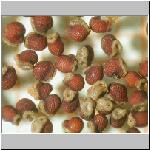 Gymnocalycium tillianum, seeds from Herbarium Mario Wick
Gymnocalycium tillianum, seeds from Herbarium Mario Wick
|
Plants differently large, fruits burst vertically on. Seeds of little, less than 1 mm in the diameter. |
Pflanzen verschieden groß, Früchte platzen vertikal auf. Samen klein, weniger als 1 mm im Durchmesser. |
G. albiareolatum Rausch 1985
G. ambatoense Piltz 1980
G. bayrianum H. Till 1987
G. bicolor Schütz 1962
G. carminanthum Borth & Koop 1976
G. castellanosii Backeberg 1936
G. chacoense Amerhauser 1999
G. chiquitanum Cardenas 1963
G. hybopleurum (K. Schumann 1898) Backeberg 1936
G. monvillei (Lemaire 1838) Britton & Rose 1922
G. mostii (Gürke 1906) Britton & Rose 1918
G. mucidum Oehme 1937
G. nigriareolatum Backeberg 1934
G. oenanthemum Backeberg 1934
G. paediophilum F. Ritter ex Schuetz 1986
G. pugionacanthum Backeberg ex H. Till 1987
G. ritterianum Rausch 1972
G. schuetzianum H. Till & Schatzl 1981
G. spegazzinii Britton & Rose 1922
G. tillianum Rausch 1970
G. valnicekianum Jajo 1934
Habitat: North of Argentina (Salta), Bolivia (South
East), Paraguay (North West)
Type: G. pflanzii (Vaupel 1923) Werdermann 1935
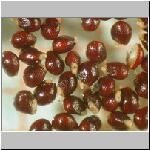 Gymnocalycium eytianum KK520, seeds from the collection Volker Schaedlich
Gymnocalycium eytianum KK520, seeds from the collection Volker Schaedlich
|
Fruits burst all horizontally on. Smaller seeds then Microsemineum; formed like a pear; redish red brown like a chestnut; Testa smooth, shiny; Hilum with Funiculusrest without a edge bulge; |
Früchte platzen alle horizontal auf. Samen birnenförmig; Samen 0,6 mm oder kleiner, kastanienbraun; Testa glatt, glänzend; Hilum mit Funikulusrest, stets ohne Randwulst |
Habitat: Argentina (Cordoba, La Rioja, Catamarca, San Juan, Santiago
del Estero, San Luis)
Type: Gymnocalycium quehlianum (F. Haage ex Quehl 1899)
Vaupel ex Hosseus 1926
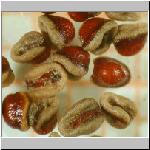 Gymnocalycium quehlianum, seeds from Herbarium Mario Wick
Gymnocalycium quehlianum, seeds from Herbarium Mario Wick
|
Little till medium-sized plants exceeding seldom 15 cm in the diameter, very flat, most solitaire. Fruits bursting spindle-shaped, vertical. Seeds to 1 mm in the diameter, like a mussel, hemispherical, pressed together, in the direction to the hilum wider. Testa bright-till dark brown look with shine as painted. Hilum is ovally basal. The bulge of the hilum is protruding very much, mostly brightly. |
Kleine bis mittelgroße Pflanzen, selten 15 cm im Durchmesser überschreitend, sehr flach, meist solitär. Fürchte spindelförmig, vertikal platzend. Samen bis 1 mm im Durchmesser, muschelförmig, halbkugelig, zusammengedrückt, in der Richtung zum Hilum verbreitert. Testa hell- bis dunkelbraun, mit Hochglanz, sehen wie lackiert aus. Hilum ist basal, oval. Der Hilumwulst ist sehr hervortretend, meist hell. |
G. bodenbenderianum (Hosseus ex Berger 1929) A.W. Hill 1933
G. obductum Piltz 1990
G. ochoterenae Backeberg 1936
G. quehlianum (F. Haage ex Quehl 1899) Vaupel ex Hosseus 1926
G. ragonesei Castellanos 1950
G. riojense Fric 1960 ex H. Till & W. Till 1991
G. stellatum Spegazzini 1925
Habitat: Paraguay (Chaco), East Bolivia (Chaco), Argentina
(San Luis, Córdoba, La Rioja, Mendoza,
Catamarca, Salta, San Juan, Tucuman, Santiago del Estero, Chaco,
Cordillera).
Type: Gymnocalycium mihanovichii (Fric ex Gürke 1905)
Britton & Rose 1922
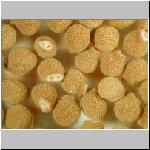 Gymnocalycium anisitsii, seeds from Herbarium Mario Wick
Gymnocalycium anisitsii, seeds from Herbarium Mario Wick
|
Plant size and form of different; some species are small, other reach to 30 cm in the diameter, some is flat, other become pillars in the age, mostly no offsets. Fruits are bursting vertically spindle-shaped. Seeds to 1 mm in the diameter, spherical or helmetshaped as Microsemineum. Testa light brown, dull, how dusts with cocoa. Hilum of little, the border bulge of some clear-cut. |
Pflanzen von verschiedenartiger Größe und Form; einige Arten sind klein, andere erreichen bis 30 cm im Durchmesser, manche sind flach, andere werden im Alter säulig, meistens nicht sprossend. Früchte sind spindelförmig, vertikal platzend. Samen bis 1 mm im Durchmesser, kugelförmig oder helmförmig wie Microsemineum. Testa hellbraun, matt, wie mit Kakaostaub bestäubt. Hilum klein, der Randwulst wenig markant. |
G. anisitsii (K. Schumann 1900) Britton & Rose 1922
G. delaetii (K. Schumann 1901) Hosseus 1926
G. eurypleurum F. Ritter 1979
G. griseo-pallidum nom. inval. Backeberg 1966
G. marsoneri Fric ex Y. Ito 1957
G. pungens Fleischer 1962
G. schickendantzii (F.A.C. Weber 1896) Britton & Rose 1922
G. stenopleurum Ritter 1979